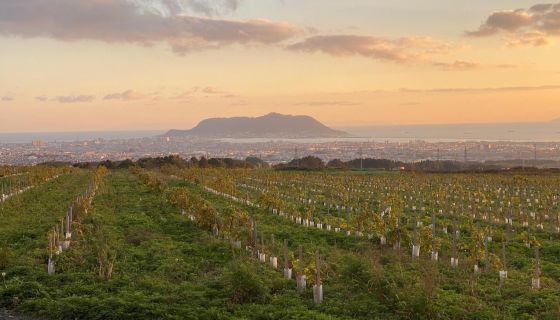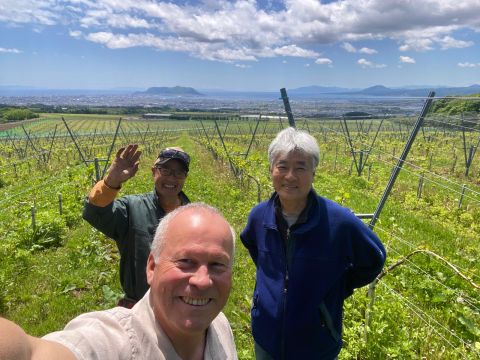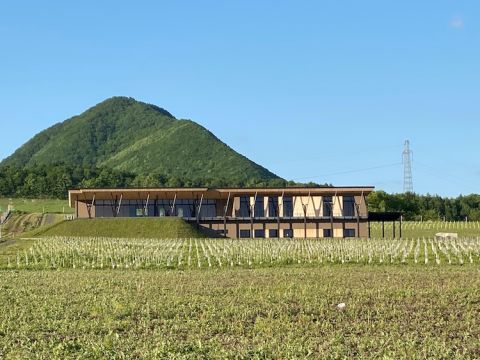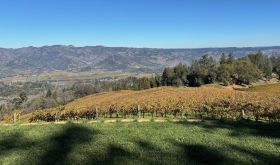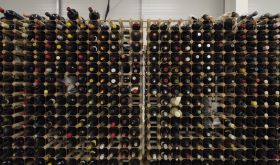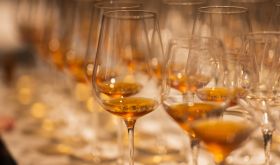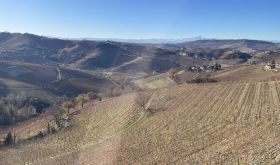Étienne de Montille is a famous producer in Burgundy with a château in Puligny-Montrachet, a busy winery in Meursault, and an enviable spread, 37 hectares (91 acres), of vines in fancy appellations on the Côte d’Or.
But, atypically for the owner of a Burgundy domaine, he has spread his wings to two more continents by committing himself and his team in 2017 to establishing wine operations in Santa Barbara County in southern California, Racines, and – even more exotically – in Hokkaido, the large northern island that is home to Japan’s ski country. Above is the view from his young vineyard. Below he is seen with Japanese colleagues.
This is quite an act of faith on the part of a European. Wine-growing in California may have a long and glorious history but it is still pretty difficult in Japan. Neither the climate nor the landscape are obviously hospitable to the grapevine. Summer rainfall is much higher than ideal.
Monsoons are a regular phenomenon from June to October, encouraging the fungal diseases to which vines are so prone. Growers have to resort to all sorts of unusual ploys to protect their grapes from rot and mildew, including, most photogenically, if most expensively, copying those who grow top-quality table grapes in Japan by providing individual bunches with their own little waterproof umbrellas.
The majority of vines are trained on overhead pergolas, which helps protect grapes from rain damage – a bit like Galicia – but also encourages eye-wateringly high yields. Many of the best vines are trained on wires with yields limited in order to maximise flavour.
And then there is the scarcity of available potential vineyard land in Japan. Anyone who has viewed the countryside from a bullet train can attest to how crowded the country is. Most wine enterprises are tiny with by far the majority of wine producers making only a few thousand cases of wine a year, from vines typically grown on small, leased plots.
This makes it all the more extraordinary that winegrowing has become so popular in Japan. The number of producers has somehow doubled to about 500 in the last 10 years.
Because of the very marked seasonal nature of the climate, the growing season is relatively short. The severity of winters means that some vines don’t bud until May, much later than in Europe, and the vines may not flower until the end of June, and there can be a desperation to pick before snows arrive in November.
The warmest south of the country is generally just too wet for successful grape-ripening and the three leading prefectures for viticulture are all further north: Yamanashi just west of Tokyo, Nagano west of Yamanashi, which benefits from some higher vineyards, and the biggest prefecture of all, the island of Hokkaido in the far north.
De Montille’s interest was piqued on a 2015 visit to Japan. ‘I was touched by the resilience, determination and humility of winemakers trying to do their best in a very challenging environment to grow grapes and make honest wines with very limited access to everything we take for granted in established wine regions. Some of them said that it could be helpful if some foreign wine estates could come and establish a vineyard in Japan so as to share knowledge and experience, and build bridges.’ He now has 15 ha (37 acres) of Pinot Noir and Chardonnay, with 2023 the first tiny harvest, and a winery in Hakodate. ‘We are very hopeful that Hokkaido can produce some beautiful, fragrant, elegant, ethereal wines that have a distinctive “umami” type of finish that I have not yet tasted anywhere else’, he wrote in an email.
Below is his spanking new Hokkaido winery.
Most of Hokkaido’s vineyards, like de Montille's, are in the south of the island – so far – and there’s more potential land available there than on Japan’s main landmass.
There’s an interesting distinction between wine grown in Japan, called Japan wine, and what is known as domestically produced wine, which is nearly five times more common in Japan and made from imported wine and grape concentrate. See more in Japan wine – past and future.
In this humid climate, hybrid vine varieties that are better equipped to resist fungal diseases are popular with growers. The most common red wine variety by far is the rather winning, strangely named Muscat Bailey A, a hybrid created in, and a speciality of, Japan that produces attractively fruity wines that can smell rather strawberry-like.
Rather more white wine is grown in Japan than red. Niagara and Delaware pale-skinned American hybrids are relatively widely planted but the most popular white wine grape by far is the Japanese pink-skinned Koshu, which is also grown for the table. No one is quite sure how this cross between a member of the European Vitis vinifera species and a Chinese species of wild vine ended up in Japan several centuries ago.
It makes rather neutral, refined dry whites that seem to me to go especially well with sashimi because they can have a similar purity, but there has been a move to imbue the wines with more flavour by reducing yields considerably from the 20 tons per hectare or more that some growers achieve.
When in Japan recently I asked several people in the know to ensure that I tasted as many hand-picked Japan wines as possible. The best whites by quite a stretch were two Yamanashi Koshus from 98WINEs, which proved, for the first time in my experience, that top-quality Koshu can age. One was a 2022, the other a 2019. The winemaker Yuki Hirayama had for many years been head winemaker for one of Japan’s few big wine companies, Kirin's Château Mercian, but has since gone solo both brewing beer and making sophisticated wines like this.
The other white wine that impressed me was a convincingly varietal Albariño from eight-year-old vines made by Shun Tamukai of Says Farm, looking pure hipster but described on his (inevitable) business card as ‘executive officer, winemaking department, farm and brewery manager’. Presumably Galicia’s Albariño has been chosen by several Japanese winegrowers because of the grapes’ thick skins and good resistance to heavy rainfall. I enjoyed both the 2022 and 2023 vintages.
Rather to my surprise, however, I was if anything more impressed by the reds than the whites in a tasting organised jointly by wine writer Hijiri Inose and wine-trade veteran Motoko Ishii.
The Muscat Bailey As were generally very charming even if not particularly suitable for long-term cellaring. And I tasted three fine Hokkaido Pinot Noirs, including the 2020 from de Montille made from bought-in fruit, a less subtle but seminal one from Takahiko Soga and another from Chitose winery, the newish Hokkaido operation of the Misawa family of Grace Wine in Yamanashi.
But perhaps the single most ambitious, if not desperately distinctive, red I encountered was a 2021 Bordeaux blend from Manns, another substantial wine producer in Japan. It was made by Teppei Nishihata, who trained in Bordeaux and Burgundy after studying at Yamanashi University. He managed to fully ripen Cabernet Sauvignon as well as Merlot grapes in Nagano prefecture. Nowadays reds can reach 14% alcohol even in Japan.
At my tasting in Tokyo he expressed concern that the brand name chosen for Manns’ top bottlings, Solaris, is also the name of a white-wine hybrid grape that is becoming increasingly popular in northern Europe and could be confusing. Since he obviously had a cosmopolitan outlook and experience, I asked him by email after my visit what were the chief differences between wine production in Japan and Europe.
‘The difficulty with winemaking in Japan is the lack of standards’, he answered. ‘We don’t yet know which grape varieties are best-suited to each region. And there are no limits on yields, which makes it difficult to work that out.’ He also complained of a lack of specialist vineyard and cellar equipment and pointed out that, when planting a vineyard, each vine is 10 times more expensive than in France. ‘But I don't think negatively about the various climates across Japan’, he added. ‘These are some of the factors that give a wine its character. We can take on any challenge!’
Recommended Japan wine
I scored all of these at least 16.5 out of 20, for what it’s worth.
White
98WINEs, Nogi Koshu 2022 Yamanashi 11%
98WINEs, Koku Koshu 2019 Yamanashi 10.5%
Katsunuma Jyozo, Aruga Branca Brilhante Koshu 2017 Yamanashi 12%
Says Farm, Private Reserve Albariño 2023 Toyama 12.8%
Says Farm, Private Reserve Albariño 2022 Toyama 13.2%
de Montille & Hokkaido Kerner 2022 Hokkaido 12.5%
Mongaku Valley, Tochi 2018 Hokkaido 12.5%
Red
Chitose, Kimura Vineyard Private Reserve Pinot Noir 2021 Hokkaido 13%
de Montille & Hokkaido Pinot Noir 2020 Hokkaido 12.5%
Takahiko Soga, Nana-Tsu-Mori Pinot Noir 2021 Hokkaido 13%
Château Mercian, Mariko Syrah Premium 2021 Nagano 12.5%
Manns Wines Komoro, Solaris La Croix 2021 Nagano 14%
Marufuji, Rubaiyat Petit Verdot 2014 Yamanashi 12.5%
Bellwood Vineyard, Collection Supérieure Muscat Bailey A 2023 Yamagata 12%
Château Mercian Muscat Bailey A 2020 Yamanashi 13%
Diamond, Chanter Y.A Huit Muscat Bailey A 2018 Yamanashi 13%
For tasting notes, scores and suggested drink dates, see Japan wine – some favourites. No international stockists as only 0.02% of Japan wine is exported.
Back to basics
| Whose ‘wine’ comes from abroad? |
|
Japan is the world’s most enthusiastic importer of grape-juice concentrate by value. Reconstituted, with a bit of added yeast, it can be transformed into something approaching wine, though is never anything like as delicious and satisfying as wine made from freshly picked grapes.
The US imported almost as much ($104 million worth as opposed to Japan’s $124 million in 2023), with China in third position. Canada has a long tradition of importing both wine and grape concentrate to supplement its own fresh-wine production and has only relatively recently made the distinction sufficiently clear on labels.
Home winemaking kits everywhere depend on grape concentrate. The reason that wine grown in the UK has for so long been known as English and not British wine is that the term British wine (or made-wine) was reserved for liquids based on reconstituted grape concentrate.
Spain, the vineyards of La Mancha in particular, are the world’s leading source of grape concentrate (which, of course, is used for a wide range of fruit drinks, too). Chile and Argentina also export it in quantity. According to international trade statistics, Italy and the US both import and export significant volumes of it.
As for the world’s leading importers of fresh wine, the top three in terms of value are, perhaps not surprisingly, the US, the UK, and Germany, which turns quite a lot of it into sparkling Sekt. More surprising is that France is the world’s fourth biggest importer of wine by volume (not value). Wherever does it go?! |

